Adam Rudolph's Moving Pictures
"A pioneer in world music" - NY Times
|
|
|
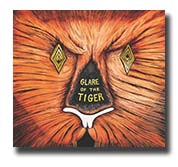 |
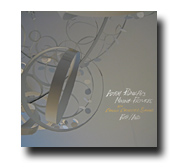 |
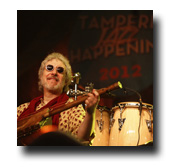 |
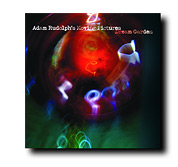 |
| Glare of the Tiger |
Both/And | Live @ Tampere | Dream Garden |
| |
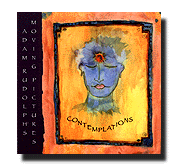 |
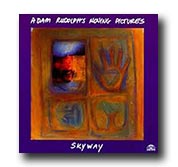 |
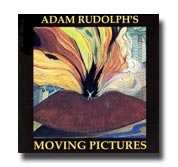 |
| 12 Arrows | Contemplations | Adam Rudolph's Moving Pictures |
"One of the year's most ecstatic performances -
in any city, any festival, anywhere." - All About Jazz
Stumbling into this imaginary clearing, the aural traveler might be astounded to find an idiosyncratic culture, at once familiar and exotic, primeval and advanced, cerebral and emotionally direct. The constantly transforming terrain can shift suddenly from Delta swampland to African veldt, from urban Chicago to rural India, conjured from Rudolph's evocative, imagistic orchestration. |
|
Since 1992, the chief population of this self-defining vista has been Moving Pictures, an amorphous ensemble formed as a vehicle for exploring Rudolph's rhythmic and intervallic concepts. The culmination to date of the composer/percussionist's ideas, an ideal commingling of personalities, instruments, craftsmanship and invention. As its title suggests, dichotomies coexist harmoniously within Rudolph's music - composition and improvisation, intuitive and intellectual, past and future, east and west. All come together in the guise of an octet comprised of highly individual musicians uniting to form a collective voice. "Creative improvised music for me is all about expressing yourself and being present in the moment of the eternal now," Rudolph explains. "Each day dawns but once. We live with the illusion of routine but we don't really know what's going to happen next. The great spiritual and mystical traditions are all about teaching us to be in the present moment. The mind loves to go forward and worry or hope, or go into and rehash the past, but all that really exists is the moment of the eternal now. That's one of the things this music celebrates because it's all about creating in the moment." |
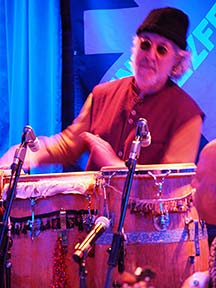 |
|
Among Rudolph's primary strengths as a composer is his ability to devise pieces that speak in his own distinct voice while allowing each of the ensemble's strongly individual instrumentalists the freedom to explore within their expansive boundaries. One model for this approach is Miles Davis, whose legendary ensembles forged unforgettable, groundbreaking music from savvy combinations of his era's greatest musicians. "One of the things that made Miles a great bandleader," Rudolph says, "is that he chose musicians who had chemistry with one another and then designed a compositional approach around the way they played. My idea for Moving Pictures was to compose a sonic environment where there's as much freedom as possible, but there's a collective idea of everybody serving the moment while expressing themselves. I'm more interested in collective improvisation than in solos. You can find this in the weaving, interactive lines of the music of Jelly Roll Morton or in Aka and Mbuti music." |
|
Those two referents exemplify the diversity of Rudolph's musical touchstones, which range from traditional to avant-garde jazz, to world music from across a range of cultures, to blues and psychedelic rock, to classical and new music. He would be quick to add "so-called" before each of those genre labels, which can be tenuous and limiting under the best of circumstances. Even a cursory listen to Rudolph's music demonstrates just how useless they become in the face of truly open-minded creation. Each member of the octet brings their own arsenal of instruments, which provides an enormous palette to draw from. Rudolph takes full advantage of those possibilities, searching for new and surprising orchestrations of color and texture from western and non-western instruments. "I've never understood why there is this codification of instrumentation," he says, "of bass, drums, piano and horns. Music can be orchestrated any way we can imagine. I encourage the musicians in Moving Pictures to be multi-instrumentalists. I think about orchestration the way any composer would, whether with a symphony orchestra or a handmade instrument collection - what colors work together, what's the balance you need to bring out the feelings and ideas in the music?" |
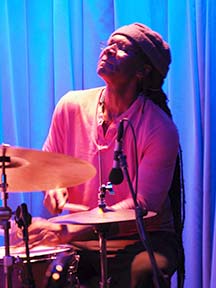 |
|
"These musicians are incredible," enthuses Rudolph about the Moving Pictures line-up. "They bring the music to life in a beautiful way. The chemistry was magical. Everyone in Moving Pictures has been working with my concepts and ideas for a number of years. They understand them both musically and philosophically and so can express themselves freely while still being true to those ideas. They all have the capacity to be multi-instrumentalists and orchestrate themselves, which provides a broad, soulful palette. I feel like everybody brings a genuine love to their expression of the music and made it come alive." The actual voices of Moving Pictures are ever-changing, but the musicians in its current incarnation all have plenty of experience with the leader's music. Much of the group has also performed with the Organic Orchestra, a 25-to-50-piece ensemble which operates by Rudolph's unique method of conducted improvisation. |
|
"I use non-linear techniques in the scoring of the compositions," Rudolph explains. "The performers can move through these environments in a multiplicity of ways, while playing freely with other musicians who also understand their potential. Nothing ever sounds incorrect, but the relationships can often be surprising, and that element of surprise is very important in my music and creative music in general." These matrices, he explains, allows the musicians a greater range of melodic options while maintaining the composer's emotional intent. As opposed to the traditional notation that moves from one note to the next in a preordained progression, Rudolph's matrices offer multiple possibilities at each given juncture. These intervallic approaches complement Rudolph's rhythmic innovations, which he refers to as "Ostinatos of Circularity", combinations of polyrhythms such as those found in African music and rhythmic cycles like those found in Indian music. "Often in African and African diasporic music, sonic rhythm patterns circle around and around in what I call "Ostinatos of Circularity". Because of this, the music becomes a call and thus a lift into transcendence. We've all heard this if we've listened to anything from Moroccan music or Samba or James Brown." |
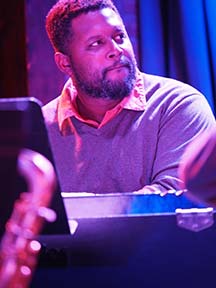 |
|
Among Rudolph's primary strengths as a composer is his ability to devise pieces that speak in his own distinct voice while allowing each of the ensemble's strongly individual instrumentalists the freedom to explore within their expansive boundaries. One model for this approach is Miles Davis, whose legendary ensembles forged unforgettable, groundbreaking music from savvy combinations of his era's greatest musicians. "One of the things that made Miles a great bandleader," Rudolph says, "is that he chose musicians who had chemistry with one another and then designed a compositional approach around the way they played. My idea for Moving Pictures was to compose a sonic environment where there's as much freedom as possible, but there's a collective idea of everybody serving the moment while expressing themselves. I'm more interested in collective improvisation than in solos. You can find this in the weaving, interactive lines of the music of Jelly Roll Morton or in Aka and Mbuti music." |
|
While his own approach to music-making has evolved considerably since that time, those earliest influences are still present in the music Rudolph composes for Moving Pictures, albeit filtered through his own progressive vision. "Blues in Orbit", for instance, is somewhat self-explanatory in that it takes an expansive approach to the blues form. Its spiraling rhythms swirl those Chicago-born sounds together with Kongo and Bantu music into a thicket of circular momentum. "The motion in that composition is what I call the Universal Mother Rhythm," Rudolph says "and the feeling is the blues. The blues is a universal sound; you hear it all over the world. We know about it most powerfully through African-American music, so when we say 'the blues', we're looking for that deep, sincere feeling, where everybody tells their story by playing their instrument with a voice-like, soulful quality. In the ancient human condition, most of which happened in Africa, music, dance, and what we could call storytelling, were all one thing," Rudolph says. "I am interested in this idea of music beyond music, music coming from something greater than music; about creative human movement and dramatic gestures." |
|
|
As a teenager, Rudolph began playing hand drums in the streets andparks in the Chicago neighborhood of Hyde Park, but was soon playing with local legends like saxophonist Fred Anderson in Chicago and the Contemporary Jazz Quintet in Detroit. His nomadic instincts soon found him traveling further and further in a quest for new musical experiences, beginning with studies throughout West Africa in 1977. The following year, he co-founded The Mandingo Griot Society, fusing African and American music, with Gambian kora player Foday Musa Suso. He spent much of 1978 living in Don Cherry's house in the Swedish countryside, where his own compositional vision began to cohere under Cherry's tutelage. In the decades since, Rudolph has studied North Indian tabla, Balinese gamelan, and music from across the African diaspora. He has married American and Moroccan sounds with Gnawa sintir player and singer Hassan Hakmoun and soloed with symphony orchestras across the United States. What is unique about the outcome of his extensive studies and travels, however, is that they have congealed into a singular music beyond style or culture. Rudolph's pieces are not jazz or avant-garde translations of the music from country "X"; they are new means of expression utilizing lessons and techniques imbibed from around the globe. The language is his, the accents multifarious. |
"Over the years I've worked with musicians from many different cultures," Rudolph says, "and what I've found interesting is not only the material information of what they're playing, the rhythms or the scales, but the deeper part, their creative attitudes and approaches towards making music. With the musicians in Moving Pictures, my goal is to inspire them to do exactly that, to project what the Dogon people of Mali call the 'Mi', the inner spirit of the person projected through the voice of the instrument." That inner voice has been important to Rudolph as instrumentalist as well as composer. "I spent years and years studying all kinds of drumming from different parts of the world, but the drummers who really influenced me most were Elvin Jones, Big Black and Tony Williams, because they were able to have their own voice on the instrument and you could recognize them in one note." It's important, he stresses, not to segregate his role as percussionist or hand drummer from his mantle of composer. The two are intimately entwined; he is, in some ways, his own most vital collaborator. "My compositional consciousness is as informed by the resonance of skin on skin when I strike my drum as it is by my study of Schillinger's mathematical scales. What I do on hand drums as a percussionist is a central dynamic in my approach as a composer." |
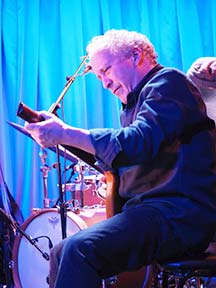 |
|
While in Ghana in 1977, Rudolph was struck by the countless one-of-a-kind, handmade instruments employed by local musicians, which translated into their own personal expression. "Anytime you have handmade instruments," he says, "the music is going to sound uniquely like itself." In a larger sense, by devising his own approach to rhythms and intervals over decades - the philosophical/compositional equivalent to hand-crafted instruments - Rudolph has constructed a vehicle for ongoing individual creation. "When you can invent new creative processes for yourself," he continues, "then you come up with prototypical art. It doesn't sound like anything else. You can't listen to it as nostalgia or in comparison with anything else, but only on its own terms. That's important because the music then becomes a clearer lens into the realm of spirit." In the realm of creative improvised music, the necessarily broad term which he uses to describe his own endeavors, Rudolph has collaborated with the likes of Don Cherry, Pharaoh Sanders, Sam Rivers, Wadada Leo Smith, L. Shankar, Jon Hassel, and Omar Sosa, among a host of others. Perhaps the most important of his myriad musical relationships is the one he has shared with multi-instrumentalist Yusef Lateef for more than twenty years. Since 1988, the two have recorded more than fifteen albums together, including a pair of concertos that each wrote for the other, released on the album Toward the Unknown in celebration of Lateef's 90th birthday in 2010. |
|
A longtime practitioner of Hatha Yoga, Rudolph sees music itself as a form of Yoga in its guise as a "unity of mind, body and spirit." There is no separation, in his view, between the musical and the metaphysical. In this way, he follows the path forged by spiritually-oriented forebears like John Coltrane. "One of the many beautiful things about John Coltrane was that he made overt in interviews and in the titles of his compositions what was always in this music," Rudolph says. "When you're dealing with this invisible alchemy in the realm of vibration, you are also dealing with the human spirit. You can project forth a sense of the evolution of your own personal mysticism." The process of forging such a personal worldview, Rudolph says, travels through three phases, structured as three basic questions: What, How and Why. In a concrete sense, this is the path any musician takes from influence to expression, but alongside that development Rudolph traces a parallel spiritual progression. |
| "Growing up, when a young musician is attracted to a particular music in their environment," he says, "I call that the 'What'. They're called to it, they don't know why, but they love it. However, in the process of developing oneself as a musician, we want to move from the 'What' into the 'How' - to learn how the music is constructed, to move beyond style into pure musical elements: melody, harmony, rhythm, intervals, and timbre. "Hopefully," he continues, "that leads into the deeper realm, the 'Why.' That implies the whole idea of what motivates an artist, their personal philosophy or cosmology. We begin to see how to think and create for ourselves. Why is in the realm of spirit and implies intent and evolution."
Rudolph's 'Why' has absorbed the lessons of numerous teachers and cultures, emerging in echoes of the primal and constructions of advanced complexity, distinctive images and mystical abstractions. "Being an artist is more than being a musician and more than being a drummer. An artist deals with the whole philosophical and cosmological aspect of what you do. As artists, we're sort of marginalized in society at this time and place - the horizontal, material realm. But in the vertical realm we're at the center. We go up into the cosmos or down into the unconscious and bring back what we discover to share with everyone else." |
|
Moving Pictures Concert Videos




